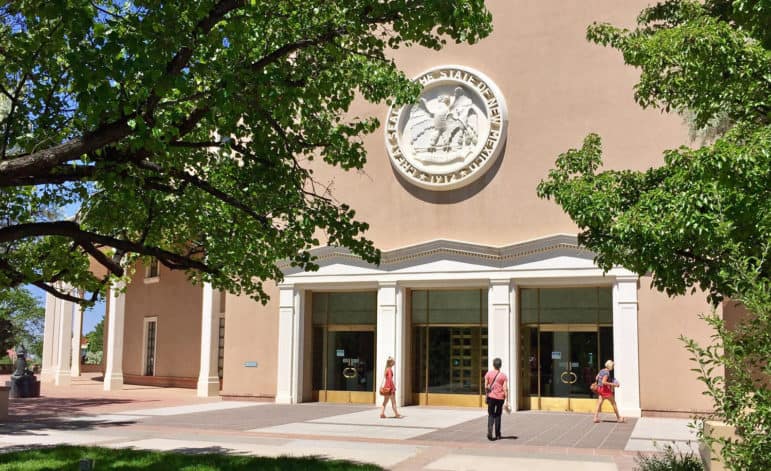
Heath Haussamen / NMPolitics.net
The Roundhouse in Santa Fe.
COMMENTARY: Three people from Las Cruces ran for statewide offices in the Democratic primaries this year. Last week, all three lost.
State Sen. Joseph Cervantes lost the race for the Democratic nomination for governor to Michelle Lujan Grisham. Doña Ana County Commissioner Billy Garrett lost the lieutenant governor’s race to state Sen. Howie Morales. State Rep. Bill McCamley lost the auditor’s race to Brian Colón.
Voters have elected Las Crucens to statewide seats in the past. Two of the last five governors, Susana Martinez and Garrey Carruthers, are from Las Cruces, the state’s second-largest city. But they’re Republicans who won general election contests, not candidates who rose to the top of the pack in Democratic primaries.
So why did none of this year’s Las Cruces candidates win? Does something about the Democratic Party create a barrier in its primaries? I asked email subscribers to NMPolitics.net last week to help me think through why all three Las Crucens lost. Responses helped me understand that it was partly due to the individual candidates on the ballot, and also partly systems and biases against the southern part of the state.
First, the issues that are individual to each race.
Lujan Grisham serves in the U.S. House and already had a strong base. She is an excellent campaigner. She entered the race early. She was able to raise a lot of money and consolidate support. Morales already had a statewide network that he built when he ran for governor in 2014. Colón had the base and name recognition that comes with running for Albuquerque mayor in 2017 and lieutenant governor in 2010. Colón is an excellent campaigner.

Heath Haussamen
But McCamley is also an excellent campaigner. And that gets us to the structural barriers Las Cruces candidates face.
There’s a disconnect that’s caused in part by Doña Ana County being the only place in the state where New Mexicans can’t get TV news from Albuquerque – and a place Albuquerque’s commercial TV stations mostly ignore.
Colón and Lujan Grisham are from Albuquerque – the center of the TV market for 32 of the state’s 33 counties. They get lots of TV coverage. Politicians from Doña Ana County do not, so they have a more challenging time becoming known statewide.
Remnants of old times are at play here. Southern New Mexico historically was a place Santa Fe politicians and other elites from the north traveled to gamble and misbehave, as the still-unsolved 1949 murder of Ovida “Cricket” Coogler reveals. Doña Ana County towns like Las Cruces and Sunland Park were intentionally off the map.
Today Las Cruces has grown into an urban center and even Sunland Park has improved its government, but the structural barrier to connection between their residents and the rest of the state still exists. We get our local TV from El Paso, Texas, not Albuquerque. As one person who responded to my email wrote, many people in Doña Ana County know more about El Paso politics than New Mexico politics. Half the jurors in former N.M. state Treasurer Robert Vigil’s 2006 corruption trial were from Doña Ana County. That’s because they knew less about the case than the other potential jurors. They didn’t have access to news about it.
And while El Pasoans see news from Doña Ana County, the rest of New Mexico rarely does. We are, in many ways, still off the map in New Mexico.
To be clear, Doña Ana County should get El Paso TV. Sunland Park is essentially a suburb of the Texas city. El Paso is the commercial center nearest to Las Cruces. People who live in Las Cruces shop in El Paso and fly out of its airport. When we need medical care that’s not accessible in Las Cruces, we often get it in El Paso. As I’ve written before, the borderlands – Southern New Mexico, El Paso and Ciudad Juárez, Mexico – are one region in three states in two countries. We should be connected by shared TV stations.
But we in Doña Ana County are also tied to the Albuquerque/Santa Fe metro area and New Mexico as a whole by our shared history and culture – and by our state government. It’s important that systems recognize this connection and help foster it, like they do in Eastern New Mexico. In recognition of connections in two different directions, towns like Clovis and Portales get TV from both Amarillo, Texas and Albuquerque.
Why can’t Doña Ana County get television from El Paso and Albuquerque? I was told years ago that car dealerships in El Paso lobbied against the idea when New Mexico’s U.S. senators floated the possibility. We can’t have Las Crucens seeing TV ads from Albuquerque and driving there instead of El Paso for deals on new cars, can we?
I can’t help but wonder also if there’s a racial component to all of this. Growing up in Santa Fe, I often heard people who identified as Spanish distinguishing themselves from Mexicans. It wasn’t uncommon to hear people make clear that they weren’t related to “those dirty Mexicans” from the south. Certainly, such attitudes have existed among white people too. Some people in the dominant culture groups in our state have historically looked down on Doña Ana County because of the presence of Mexican people and culture here. Many of our communities are predominantly Spanish speaking. Even our chile is different.
Which makes me think about how, many decades ago, Doña Ana County was a dirty little secret, the weekend playground for politicians from the north. Does this all help explain why Clovis and Portales got a dual media market at some point in their history and Doña Ana County did not? Given the way cultural biases creep into systems, maybe.
And it may make sense that such a bias against the borderlands is stronger in the Democratic Party. Its power has long been concentrated in Northern New Mexico, while the state Republican Party’s power is spread out from the oil patch in the southeast to the oil patch in the northwest.
I suspect all of this helps explain why Las Crucens have a harder time in statewide Democratic primaries than elections that are open to all voters.
Perhaps distance is also a related issue in our big state. One person who responded to my email said it’s really important that candidates from the south talk about local issues in Northern New Mexico, where familial and other connections matter immensely. Policy-wise, Las Cruces has become a progressive-dominated city – and progressive-versus-conservative politics are not without a racial dynamic in New Mexico, especially in the Democratic Party. A white, progressive Las Crucen who campaigns on fighting President Donald Trump’s policies, like McCamley, may simply not resonate with norteños for whom all politics is local. And on top of that, he’s from a community that’s hundreds of miles away instead of a familiar city like Santa Fe. In other words, an outsider.
That’s exactly the sort of belief that a shared TV market for all New Mexicans would help combat.
Finding ways to build better understanding and cooperation among all New Mexicans is critical to improving our state. We must dismantle discriminatory systems that get in the way. Including Doña Ana County in the Albuquerque TV market would increase connection between people living in the state’s second largest urban center and everyone else. And it would give candidates from Doña Ana County a fairer shot in elections.
It’s time for our congressional delegation in Washington to make this a priority.
Heath Haussamen is NMPolitics.net’s editor and publisher. Agree with his opinion? Disagree? NMPolitics.net welcomes your views. Learn about submitting your own commentary here.